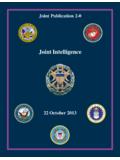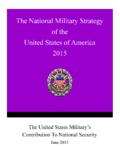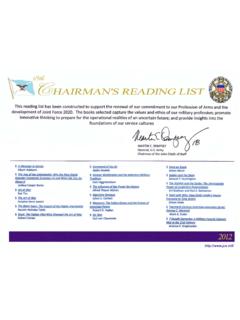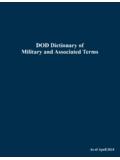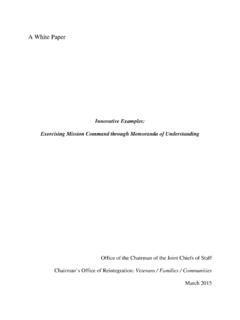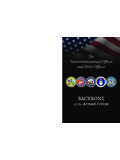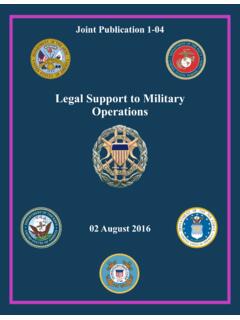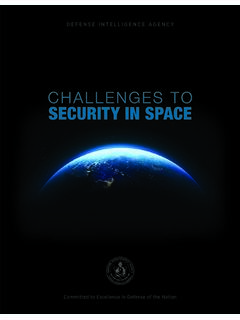Transcription of JP 2-01, Joint and National Intelligence Support to ...
1 DEPAOTMENTFTHEARMY EUNITEDSTATSOAFAMERICRTHISWE'LLDEFENDJ oint Publication 2-01 Joint and National IntelligenceSupport to Military Operations5 July 2017 i PREFACE 1. Scope This publication provides doctrine for Joint and National Intelligence products, services, assessments, and Support to Joint military operations. 2. Purpose This publication has been prepared under the direction of the Chairman of the Joint Chiefs of Staff (CJCS). It sets forth Joint doctrine to govern the activities and performance of the Armed Forces of the United States in Joint operations, and it provides considerations for military interaction with governmental and nongovernmental agencies, multinational forces, and other interorganizational partners.
2 It provides military guidance for the exercise of authority by combatant commanders and other Joint force commanders (JFCs), and prescribes Joint doctrine for operations and training. It provides military guidance for use by the Armed Forces in preparing and executing their plans and orders. It is not the intent of this publication to restrict the authority of the JFC from organizing the force and executing the mission in a manner the JFC deems most appropriate to ensure unity of effort in the accomplishment of objectives. 3. Application a. Joint doctrine established in this publication applies to the Joint Staff, commanders of combatant commands, subunified commands, Joint task forces, subordinate components of these commands, the Services, and combat Support agencies.
3 B. The guidance in this publication is authoritative; as such, this doctrine will be followed except when, in the judgment of the commander, exceptional circumstances dictate otherwise. If conflicts arise between the contents of this publication and the contents of Service publications, this publication will take precedence unless the CJCS, normally in coordination with the other members of the Joint Chiefs of Staff, has provided more current and specific guidance. Commanders of forces operating as part of a multinational (alliance or coalition) military command should follow multinational doctrine and procedures ratified by the United States.
4 For doctrine and procedures not ratified by the US, commanders should evaluate and follow the multinational command s doctrine and procedures, where applicable and consistent with US law, regulations, and doctrine. Preface ii JP 2-01 4. Contribution The following staff, in conjunction with the Joint Doctrine Development Community, made a valuable contribution to the revision of this Joint Publication: Lead Agent and Joint Staff Doctrine Sponsor LtCol Glen Weaver, Joint Staff J-2; Joint Analysis Division Action Officer Mr. Mark Brown, Joint Staff J-7, Joint Doctrine Analysis Division; and Joint Doctrine Action Officer LTC Gregory Browder, Joint Staff J-7, Joint Doctrine Division.
5 For the Chairman of the Joint Chiefs of Staff: KEVIN D. SCOTT Vice Admiral, USN Director, Joint Force Development iii SUMMARY OF CHANGES REVISION OF Joint PUBLICATION 2-01 DATED 05 JANUARY 2012 Clarifies the difference within a Joint Intelligence operations center (JIOC) between a red team and a red cell. Adds appendices: Target Intelligence , Global Intelligence , Surveillance, and Reconnaissance Management, and Joint Exploitation Support to Intelligence . Describes information operations Intelligence integration as a military capability that supports information operations. Clarifies identity Intelligence , identity Intelligence production, and associated identity activities.
6 Restructures Chapter III, Section B, Collection, and clarifies collection management, collection requirements management, and collection operations management functions. Clarifies the role of Joint Intelligence planners to coordinate the planning and direction portion of the Joint Intelligence process. Describes Intelligence Support to cyberspace operations and cyberspace Intelligence , surveillance, and reconnaissance considerations. Clarifies the roles and responsibilities of the JIOC with increased emphasis on the Intelligence mission management function. Emphasizes the role of the J-2 to ensure the integration of Intelligence resource management within the operations cycle of the Joint force.
7 Defines the Defense Intelligence Agency s roles and responsibilities as the defense Intelligence collection manager. Describes each of the Service Intelligence organizations and their capabilities. Clarifies the difference between an Intelligence , surveillance, and reconnaissance activity and an Intelligence collection capability or asset. Expands the discussion of counterintelligence activities to include protecting information and information systems and combatting transnational organized crime. Summary of Changes iv JP 2-01 Describes weapons technical Intelligence as a subcategory of technical Intelligence .
8 V TABLE OF CONTENTS PAGE EXECUTIVE SUMMARY .. ix CHAPTER I THE ROLE OF Intelligence IN MILITARY OPERATIONS Introduction .. I-1 Intelligence Challenges .. I-2 Intelligence Support to Military Operations .. I-3 CHAPTER II Joint AND National Intelligence ORGANIZATIONS, RESPONSIBILITIES, AND PROCEDURES Introduction ..II-1 Section A. Joint Intelligence Overview ..II-1 Joint Staff, Directorate for Intelligence ..II-1 Combatant Command Intelligence Organizations and Responsibilities ..II-1 Subordinate Joint Force Intelligence Organizations and Responsibilities ..II-7 Section B. National Intelligence Overview ..II-11 Department of Defense Intelligence and Combat Support Agency Organizations and Responsibilities.
9 II-12 National Intelligence Community Organizations and Responsibilities ..II-21 Joint and National Intelligence Support Forums ..II-24 Intelligence and the Department of Defense Information Network ..II-27 Intelligence Communications Architecture Planning ..II-32 Section C. Interagency, Intergovernmental, and Multinational Intelligence Sharing Overview ..II-34 Multinational Intelligence Collaboration ..II-36 International Intelligence Sharing ..II-38 Interorganizational Intelligence Collaboration ..II-39 CHAPTER III Intelligence OPERATIONS Introduction .. III-1 The Intelligence Process .. III-1 Table of Contents vi JP 2-01 Section A.
10 Planning and Direction Overview .. III-4 Intelligence Planning .. III-4 Intelligence Requirements and Information Requirements Planning .. III-8 Resource Allocation .. III-10 Requesting National Intelligence .. III-10 Section B. Collection Overview .. III-13 Collection Management .. III-14 Collection Requirements Management .. III-18 Collection Operations Management .. III-20 Types of Collection Operations .. III-35 Collection Agencies and Sources .. III-36 Section C. Processing and Exploitation Overview .. III-38 Human Intelligence .. III-39 Geospatial Intelligence .. III-41 Signals Intelligence .. III-41 Measurement and Signature Intelligence .
